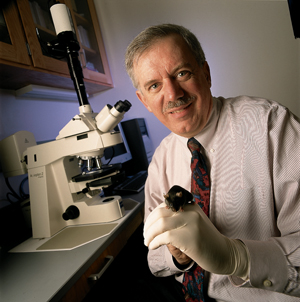
Mark Magnuson, M.D.
Missing fat sheds light on diabetes mechanisms
Deleting just one gene in the fat cells of mice has marked effects on fat formation, diet-induced obesity, and insulin resistance, Vanderbilt University Medical Center investigators reported this month.
The findings, published in the journal Proceedings of the National Academy of Sciences, represent “a major step forward” in efforts to understand how fat cells affect glucose metabolism and insulin action, said the study’s senior author, Mark A. Magnuson, M.D., professor of Molecular Physiology & Biophysics and Medicine and director of the Vanderbilt Center for Stem Cell Biology.
The Vanderbilt investigators, in collaboration with Barbara Kahn, M.D., at Beth Israel Deaconess Medical Center, genetically engineered mice to lack the gene for a nuclear receptor called PPAR-gamma only in fat cells — a so-called “tissue-specific knockout.” PPAR-gamma is a “transcription factor,” a protein that turns other genes on or off.
“PPAR-gamma is a phenomenally important transcription factor,” Magnuson said. “It’s widely expressed and is being studied at Vanderbilt by investigators interested in diabetes, obesity, colon cancer, atherosclerosis and kidney function.”
PPAR-gamma is the molecular target for a class of drugs called thiazolidinediones, which improve insulin action and lower blood glucose levels in patients with type 2 diabetes. They are the first drugs to address the underlying problem of insulin resistance and are now a mainline therapy for type 2 diabetes, Magnuson said.
Despite the success of these drugs, “how they work is really still quite a black box,” Magnuson said. “That’s something this research helps to address.”
Magnuson and colleagues used a genetic targeting strategy to specifically eliminate PPAR-gamma in the fat cells of mice. Mice missing the protein had much less fat than normal mice, and completely lacked thermogenic brown fat. When they were fed a high-fat diet, which causes obesity and insulin resistance in normal mice, the fat-specific PPAR-gamma knockout mice did not gain weight and did not become glucose intolerant or insulin resistant.
The authors examined the role of the liver and other hormones, including adiponectin and resistin, in preventing high fat diet-induced insulin resistance.
“The liver has always been thought to be a central player in blood glucose maintenance, and how it responds in different settings is still rather mysterious,” Magnuson said. “In these mice, it appears that improved glucose metabolism by the liver is contributing to the prevention of insulin resistance.”
The current report does not solve all of the complexities of PPAR-gamma’s role in glucose metabolism, Magnuson said. It confirms an important role for the receptor in fat, suggests that PPAR-gamma is more important in liver than previously believed, and offers another tool for ongoing research in the area, he said.
Magnuson expects that the fat-specific PPAR-gamma knockout mice, along with similar models created by other groups, will be useful in unraveling the complex tapestry of molecular interactions that underlie glucose metabolism and insulin action.
“The value of tissue-specific knockout mice is very high because they allow you to tease things apart in a very deliberate way, one pathway at a time,” Magnuson said. “Every tissue-specific knockout we’ve made has given some new insight that couldn’t be predicted from previous data.”
Julie R. Jones, Ph.D., is the first author of the PNAS paper. The research was supported by the National Institute of Diabetes & Digestive & Kidney Diseases, part of the National Institutes of Health.













